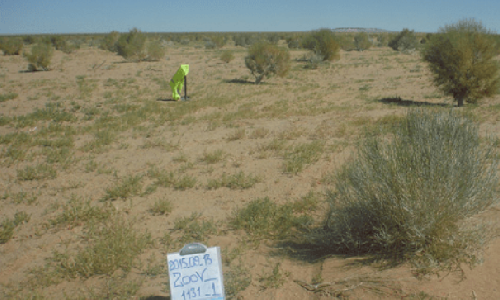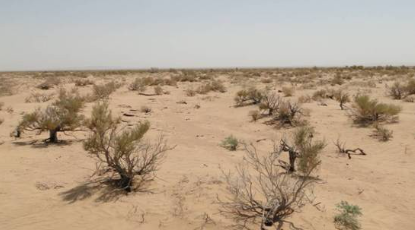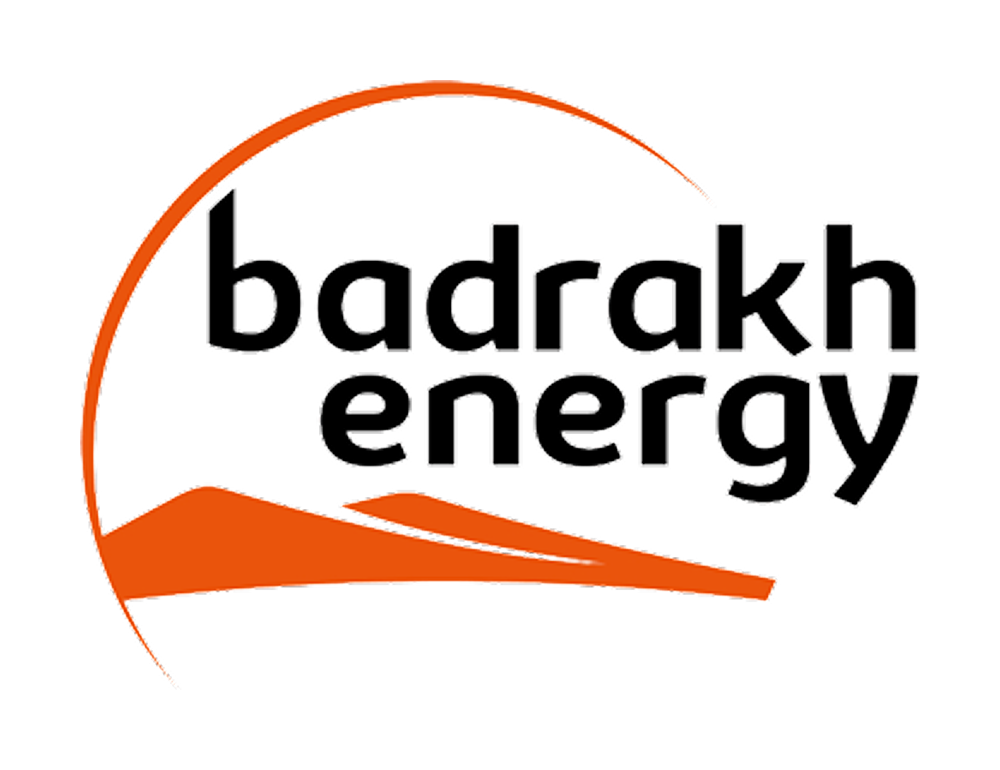ENVIRONMENT
Every mining operation requires the development of infrastructure and use of raw materials and resources, especially water and energy. And the impact of mining on the natural environment is constantly assessed, minimized, controlled and monitored.
Back Title
This is back side content.
In 2022, Badrakh Energy reaffirmed its dedication to upholding the highest international standards by signing the Responsible Mining Code initiated by the National Mining Association of Mongolia. This action not only underscores our commitment to the environment, but also positions us as exemplary in the industry.
Back Title
This is back side content.
Badrakh Energy conducted all the necessary environmental and social studies and risk assessments before launching the Zuuvch Ovoo ISR Pilot test project performed in 2021-2022.
Back Title
This is back side content.
Sustainable development is defined by ensuring environmental protection in every step of our activity.
Before the project begins
- EMP – environmental management plan
- Radiological monitoring program
- Water Conclusion – water usage permit
- Water use contract
- Waste management contract
- Waste water conclusion
- Fire conclusion
- Chemicals permit
Badrakh Energy operates in accordance with approvals provided by the Ministry of Environment and Tourism, the Ministry of Mines and Heavy Industry, the Ministry of Education and Science, the Water Authority, the Water Basin Authority of Galba Oosh Dolood and NEMA (National Emergency Management Authority) and the Environment and Tourism Department of Dornogobi. These regulatory agencies provide permits and conditions annually for our operations, as well as review and approve projects, and conduct audits, and inspections to ensure the company is meeting its commitments.
The Health, Safety-Radioprotection, and Environment Department of Badrakh Energy collaborates closely with professional agencies and organizations to ensure that environmental programs adhere to regulatory standards, maintain consistency, and accuracy, and are effectively implemented.
BADRAKH ENERGY HAS PERFORMED THE FOLLOWING ENVIRONMENTAL SURVEYS:
2009
Environmental and socio – economic baseline study of Dulaan Uul uranium exploration project
2009 – 2013
Radiation protection activities performed for uranium exploration and study in 2009 – 2013
2010
DEIA report on ISR pilot project in Umnut deposit
2011
- Report on air quality and soil monitoring in the vicinity of pilot project for uranium mining by ISR technology in Umnut deposit of Cogegobi LLC
- Report on nuclear and radiation safety during ISR test of uranium mining
2010 – 2011
Report on the results of the environmental baseline assessment study performed during the pilot project of uranium mining by ISR in Umnut deposit of Cogegobi LLC
2012
- Environmental and socio – economic baseline study of Zuuvch Ovoo (11946X) exploration site
- Results of report on environmental assessment study conducted during ISR test performed in Umnut deposit of Cogegobi LLC
2012 – 2014
- Environmental baseline study of Zuuvch Ovoo
- Environmental Protection Plan and Environmental Monitoring Program Reports of Dulaan Uul and Zuuvch Ovoo sites from 2012 – 2014
2014
- Radiation safety monitoring plan
- Report on the archeological conservation research carried out in the exploration licensed area of Dulaan Uul in Ulaanbadrakh soum of Dornogobi Province
2014 – 2015
Ecological risk assessment
2014 – 2016
Paleontological study of Zuuvch Ovoo, Dulaan Uul
2014/11 – 2016/03
DEIA – Environmental Management Plan of Zuuvch Ovoo
2015
- Land quality assessment
- Environmental audit
2015-2016
Detailed environmental impact assessment report of the ISR pilot test in Zuuvch Ovoo uranium deposit
2015-2017
Assessment and remediation study on Khar Yamaat saxual forest in Ulaanbadrakh soum of Dornogobi province
2016
- Environmental assessment state study on Zuuvch Ovoo
- Independent environmental control and monitoring
2017
Disaster risk assessment survey of Zuuvch Ovoo project
2017 – 2018
Chemical risk assessment
2018
- Radiological assessment of workplace of Zuuvch Ovoo pilot test and recommendations for radioprotection
- Independent environmental control and monitoring
- Implementation of offset program-consulting service and study
2018 – 2019
Study of mammals and birds
2019
- Independent environmental control and monitoring
- Implementation of offset program-consulting service and study
2020
- Land quality assessment
- Environnemental audit
- Third Party Review of Documents Pertaining to Reported Cattle Deaths in the Umnut license area of Dulaan Uul, Mongolia
2022
Radiation safety and workplace radiation assessment
2022 – 2023
- Environnemental audit
- Environmental assessment report of Dulaan Uul and Zuuvch Ovoo
DURING THE PROJECT DEVELOPMENT STAGE
Detailed environmental impact assessment (DEIA)
The DEIA can be considered as a guideline for environmental protection of the project area. The DEIA provides a detailed understanding of the associated environment (biodiversity inventory, socio-economic status of the region), and identifies all preventative or mitigating measures necessary for reducing risks at the source. An action plan for mitigation is developed and implemented and, when needed, offset measures can be proposed. It also includes the principles of remediation to be deployed at the end of the mine’s life and environmental monitoring.
The DEIA is subject to regulatory review and approval and a yearly financial deposit to assure the remediation plan is carried out after mining activity, in accordance with the Law on Environmental Assessment of Mongolia. The five-year-DEIA update reflects the changes of activities, all new environmental data, social aspects and technological updates for environmental protection.
Additionally, it considers identified environmental issues, changes to the physical facility or facility processes, adjustments in project scope or schedule, scientific advances or regulatory requirements.
ENVIROMENTAL MONITORING
Environmental monitoring is maintained and reinforced from construction to operation. And an environment management system has been implemented on site.
Mechanisms are set to systematically monitor the soil, water, and air and, including the food chain of herders, particularly in areas near where people live, work and travel.
We also had different independent monitoring and surveys conducted with the relevant authority, which proved that our activity doesn’t impact the environment, especially underground water, plant, soil and livestock health.
A special PEMP was dedicated to the Zuuvch Ovoo ISR Pilot to monitor the herders’ water well, located near the project site. This program proves that there is no impact due to the ISR Pilot project.
Badrakh Energy was named as a “Best Practice” by the workshop entitled “Best Practice on the Participatory Environmental Monitoring” held in April 2019 by the Ministry for Environment and Tourism of Mongolia.
Environmental research and analysis

Environmental research and analysis actions carried out since exploration stage:
- Report of the study on animal species, population, migration, movement and habitat of ungulates (mammals) and birds
- Report of the environmental audit at the uranium project implemented by Badrakh Energy
- Justification and plan of establishing the tree cultivation site and carrying out reforestation through planting saxauls.
- According to the monitoring results and independent assessments, no negative impact on environment has been identified from Badrakh Energy operation during the pilot production stage.
Monitoring of radiation
Monitoring of radon in the air
Badrakh Energy, which engages in radiation-related activities, follows the requirement of “monitoring the concentration of aerosols and radioactive gas in the workplaces and other facilities of the organization” and has performed monitoring of radon in the air every two weeks, every month and every two months, depending on the risk levels.
For example, in a warehouse of uranium- charged resins where radon cumulation can be the highest, the highest result registered is 149 Bq/m3. This figure is 7 times lower than 1110 Bq/m3, which is the maximum authorized limit for people working with radioactivity.
Monitoring of radiation in the environment
Badrakh Energy commissioned the Nuclear Research Laboratory to perform an analysis of radioactive isotopes and heavy metals in the soil, groundwater and surface water, to monitor the background radiation level in the environment, comparing it with the permissible level under the relevant standard, and make an observation.
WATER
A precious natural resource, water is essential to the well-being of the communities and environment where Badrakh Energy operates, as well as to the smooth- running of Badrakh Energy’s mining operations.
Groundwater and aquifer in the Zuuvch Ovoo area
Advanced exploration for Zuuvch Ovoo began in 2011. This involves detailed delineation of the deposit in order to measure the quantity, grade, and geometry of the uranium ore bodies, as well as hydro-geological studies and the geological environment. Water is a vital natural resource, and understanding where it is and how it moves underground is essential in protecting this resource. By using geological maps and taking samples of underground and surface water for analysis, hydrogeologists are building a detailed picture of how water flows underground.
– Aquifers are underground permeable layers that are mostly made of sand, where groundwater is stored and moves slowly over time
– Groundwater is part of the water cycle and is heavily dependent on the climate. Groundwater conditions in the Zuuvch Ovoo area have been studied since 2006, through a network of 200 monitoring wells
– The groundwater is not suitable for drinking, according to national and international standards
– This poor groundwater quality is partially due to the fact that groundwater has been slowly interacting with minerals in the aquifer over thousands of years.
– ISR technology consumes up to 5 times less water than underground or open-pit mining technologies.
Biodiversity
To deal with the erosion of biodiversity related to mining projects, the “mitigation hierarchy”, also known as the “avoid – minimize – remediate/ restore – offset” sequence, has been in place from the first phases of the project, in accordance with the recommendations of the environmental impact studies.
Our objective is to work towards no net loss of biodiversity. Although the impact on the environment from the project is very small, the company is taking steps to reduce the impact on biodiversity from the work on the site by:
– Ensuring the field work area occupies as little space as possible and preventing it from spreading over a large area
– Preventing accidental spillage of oils from vehicles and soil pollution
Taking preventive and protective actions, such as protecting and isolating the flora, namely, the saxaul plant on the project site.
REMEDIATION
Mining operations require the development of infrastructure (supply of energy, roads, facilities) for the processing of uranium ore, which has an impact on the natural environment and needs to be assessed, minimized and controlled. In order to anticipate risks, remediation is considered right from the exploration and development phases of mining projects.
Although some remediation work is carried out throughout the active period, most of the technical work takes place when mining operations are completed. The employment-related and social implications of the closure of a site are considered as far upstream as possible, in coordination with the competent authorities and in consultation with all internal and external stakeholders.
Optimal planning and implementation of the rehabilitation works plays a crucial role in maintaining the confidence of local communities, authorities and all stakeholders involved. It is key to the long-term acceptability of our activities and our «license to operate» in the communities and in the host countries where we are made welcome.
Remediation plan for the project
– Well field: plugging the wells, dismantling the piping network and rehabilitation of land
– Industrial facilities: dismantling, demolition and rehabilitation of land
– Water table: restoration by natural attenuation, based on various hydrogeological studies and studies demonstrating the effectiveness of natural attenuation with regard to the aquifers in the areas mined
– Revegetation: plantation of saxauls (protected local trees) in rehabilitated areas and in neighboring areas as part of an environmental offset project
Ongoing monitoring of water tables through a network of 88 piezometers. A dedicated budget scheduled to perform all site remediations
Monitoring & Remediation work control
Every year Badrakh Energy submits its environmental monitoring plans to the Ministry of the Environment and Tourism and the remediation work is carried out systematically on completion of exploration activities. These action plans are audited by local authorities and then by the regional environmental protection department before the Annual Environmental Monitoring Report is submitted to the Ministry of Environment and Tourism.


Case studies
Case study 1: Saxual compensation project for Zuuvch Pilot
As part of the preparation of the Zuuvch Ovoo ISR pilot site, the detailed environmental impact study determined that a number of saxauls situated in the pilot area would be impacted. Therefore Badrakh Energy opted for unique compensation.
Upstream of the project, the majority of the facilities will be built outside the high density saxaul zones and Badrakh Energy will ensure strict management of the tracks.
The company has offered to replant saxauls and other endemic species over a surface area equivalent to that affected by the pilot (5 ha). The compensation measure will be carried out in an area close to the pilot and compatible with the sustainable recovery of the trees, in a location chosen in agreement with the stakeholders and respecting local traditions. Thus, in order to create a positive societal and environmental dynamic, stakeholders will be involved and the work will be carried out by local companies and professionals specializing in the replanting of trees in arid regions.
After four years of studies, the planting started in 2019- 2021 and should last till 2022. The monitoring of the plants’ growth will continue for four to five more years.

The Billion Trees project
Badrakh Energy has joined the national program to plant 1 billion trees initiated by the President of Mongolia. The company is committed to planting 5 million trees during the period of mine exploitation


